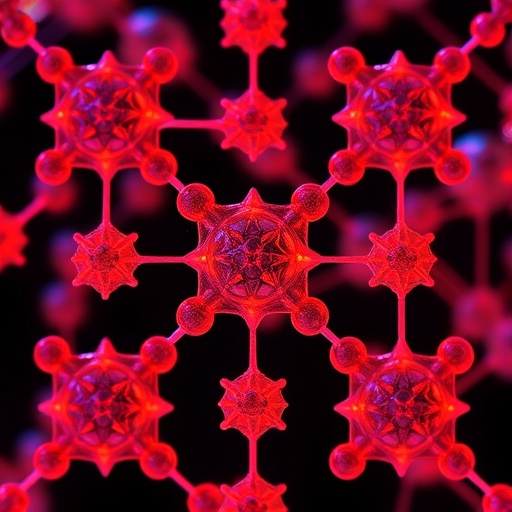In a rapidly evolving field of photocatalysis, the quest to develop sustainable and efficient chemical processes has gained renewed momentum. Assistant Professor Xiaoyan Tan from George Mason University’s Department of Chemistry and Biochemistry has recently been awarded a significant grant aimed at investigating the promising potential of ferroelectric oxides as heterogeneous photocatalysts in the selective dehydrogenation of ethane. This innovative research is poised to contribute transformative insights into the catalytic mechanisms involved and may pave the way for greener industrial applications in petrochemical processing.
The project, supported by a $125,000 grant from the American Chemical Society, is scheduled to commence in September 2025 and will run through August 2027. The funding will facilitate a thorough exploration of ferroelectric oxide materials, a class of compounds that possess spontaneous electric polarization, making them uniquely suited for photocatalytic applications. By harnessing the intrinsic electric fields present within these materials, the research aims to enhance the activation of ethane molecules, a crucial step in converting this relatively inert hydrocarbon into more valuable chemical feedstocks.
Ethane dehydrogenation is a highly sought-after reaction in industrial chemistry, serving as a foundation for producing ethylene, a cornerstone molecule in the manufacture of plastics, solvents, and numerous other chemical products. Conventional thermal catalytic methods rely heavily on high temperatures, which limit efficiency and increase carbon emissions. Photocatalytic approaches have emerged as a promising alternative, utilizing light energy to drive reactions under milder conditions. Yet, challenges remain in finding catalysts that are both active and selective while exhibiting long-term stability.
Ferroelectric oxides exhibit a distinctive blend of electronic properties that enable charge separation and localized electric fields at their surfaces. This environment can potentially lower the activation energy required for cleaving robust carbon–hydrogen bonds in ethane, enabling a more controlled and energy-efficient dehydrogenation process. Tan’s investigation will delve into the physicochemical attributes of various ferroelectric oxides, examining how their crystal structure, polarization dynamics, and defect chemistry influence their photocatalytic performance.
A core facet of the study involves the synthesis and characterization of novel ferroelectric oxide materials with tailored morphologies and compositions, designed to optimize light absorption and charge carrier mobility. Advanced spectroscopic and microscopic techniques will be employed to probe the interaction between incident photons and the catalyst surface, unveiling mechanisms of photoinduced electron transfer and catalytic turnover. The interdisciplinary methodology promises to combine experimental observations with theoretical modeling to elucidate the fundamental principles governing photocatalytic activity.
Moreover, the research will investigate the stability of ferroelectric oxide photocatalysts under reaction conditions. Photocatalysts are often prone to degradation, which hampers their practical application. Understanding the pathways of deactivation and developing strategies to mitigate catalyst deterioration are paramount to advancing photocatalytic technologies toward commercial scalability.
Tan’s work is positioned at the confluence of materials science, surface chemistry, and photophysics, with broad implications for sustainable chemical manufacturing. Success in this endeavor could unlock new paradigms in hydrocarbon processing, enabling the production of high-value chemicals from abundant, low-cost feedstocks under environmentally benign conditions. Such advances align with global efforts to reduce the carbon footprint of chemical industries and transition toward renewable energy integration.
The importance of this research is underscored by the emerging interest in ferroelectric materials for photoelectrochemical applications beyond ethane dehydrogenation, including water splitting, CO₂ reduction, and organic synthesis. By expanding our understanding of ferroelectric oxide photocatalysts’ behavior, the project has the potential to catalyze innovations across multiple domains of clean energy and green chemistry.
George Mason University, Virginia’s largest public research institution, continues to foster cutting-edge scientific exploration through initiatives like this. With a diverse and dynamic scholarly community, the university is committed to advancing technological frontiers and addressing critical societal challenges. Tan’s investigation exemplifies this mission, offering a glimpse into the future of catalysis powered by advanced functional materials.
The upcoming studies will also integrate collaborative efforts with computational chemists and process engineers to translate laboratory-scale findings into viable technologies. This translational approach is essential for bridging the gap between fundamental research and industrial application, ensuring the relevance and impact of the scientific outcomes.
As the project unfolds over the next two years, it is expected to produce a series of high-impact publications and presentations that will enrich the scientific discourse on photocatalysis and materials design. The detailed understanding of ferroelectric oxide photocatalysts derived from this work will inspire subsequent research and development in related fields.
In summary, Assistant Professor Xiaoyan Tan’s investigation into ferroelectric oxides as heterogeneous photocatalysts for ethane dehydrogenation marks a significant stride toward sustainable catalytic processes. By leveraging the unique properties of ferroelectric materials, the research aims to demonstrate a viable pathway for light-driven hydrocarbon transformation, potentially revolutionizing chemical manufacturing and contributing to global environmental goals.
Subject of Research: Investigation of ferroelectric oxides as heterogeneous photocatalysts for ethane dehydrogenation
Article Title: Tan To Conduct Investigation Of Ferroelectric Oxides As Heterogeneous Photocatalysts For Ethane Dehydrogenation
News Publication Date: (Not provided)
Web References: http://www.gmu.edu/
Keywords
Physical sciences, Chemistry




